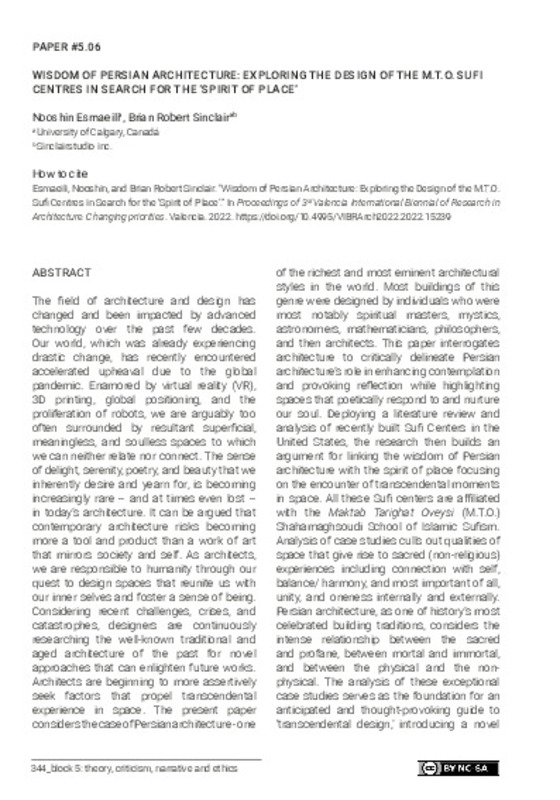JavaScript is disabled for your browser. Some features of this site may not work without it.
Buscar en RiuNet
Listar
Mi cuenta
Estadísticas
Ayuda RiuNet
Admin. UPV
Wisdom of Persian Architecture: Exploring the Design of the M.T.O. Sufi Centres in Search for the ‘Spirit of Place’
Mostrar el registro sencillo del ítem
Ficheros en el ítem
| dc.contributor.author | Esmaeili, Nooshin
|
es_ES |
| dc.contributor.author | Sinclair, Dr. Brian
|
es_ES |
| dc.date.accessioned | 2023-12-21T12:52:25Z | |
| dc.date.available | 2023-12-21T12:52:25Z | |
| dc.date.issued | 2023-05-22 | |
| dc.identifier.isbn | 9788413960265 | |
| dc.identifier.uri | http://hdl.handle.net/10251/201023 | |
| dc.description.abstract | [EN] The field of architecture and design has changed and been impacted by advanced technology over the past few decades. Our world, which was already experiencing drastic change, has recently encountered accelerated upheaval due to the global pandemic. Enamored by virtual reality (VR), 3D printing, global positioning, and the proliferation of robots, we are arguably too often surrounded by resultant superficial, meaningless, and soulless spaces to which we can neither relate nor connect. The sense of delight, serenity, poetry, and beauty that we inherently desire and yearn for, is becoming increasingly rare -- and at times even lost -- in today’s architecture. It can be argued that contemporary architecture risks becoming more a tool and product than a work of art that mirrors society and self. As architects, we are responsible to humanity through our quest to design spaces that reunite us with our inner selves and foster a sense of being. Considering recent challenges, crises, and catastrophes, designers are continuously researching the well-known traditional and aged architecture of the past for novel approaches that can enlighten future works. Architects are beginning to more assertively seek factors that propel transcendental experience in space. The present paper considers the case of Persian architecture - one of the richest and most eminent architectural styles in the world. Most buildings of this genre were designed by individuals who were most notably spiritual masters, mystics, astronomers, mathematicians, philosophers, and then architects. This paper interrogates architecture to critically delineate Persian architecture’s role in enhancing contemplation and provoking reflection while highlighting spaces that poetically respond to and nurture our soul. Deploying a literature review and analysis of recently built Sufi Centers in the United States, the research then builds an argument for linking the wisdom of Persian architecture with the spirit of place focusing on the encounter of transcendental moments in space. All these Sufi centers are affiliated with the Maktab Tarighat Oveysi (M.T.O.) Shahamaghsoudi School of Islamic Sufism. Analysis of case studies culls out qualities of space that give rise to sacred (non-religious) experiences including connection with self, balance/ harmony, and most important of all, unity, and oneness internally and externally. Persian architecture, as one of history’s most celebrated building traditions, considers the intense relationship between the sacred and profane, between mortal and immortal, and between the physical and the non-physical. The analysis of these exceptional case studies serves as the foundation for an anticipated and thought-provoking guide to ‘transcendental design,’ introducing a novel approach for designers that encourages advancing beyond the physical form to pursue and optimize the vital intersection of wisdom, space, place, and self. | es_ES |
| dc.format.extent | 15 | es_ES |
| dc.language | Inglés | es_ES |
| dc.publisher | Editorial Universitat Politècnica de València | es_ES |
| dc.relation.ispartof | Proceedings - 3rd Valencia International Biennial of Research in Architecture, VIBRArch | |
| dc.rights | Reconocimiento - No comercial - Compartir igual (by-nc-sa) | es_ES |
| dc.subject | Persian architecture | es_ES |
| dc.subject | Theory | es_ES |
| dc.subject | Transcendental space | es_ES |
| dc.subject | Unity | es_ES |
| dc.subject | Sacred space | es_ES |
| dc.subject | Spirituality | es_ES |
| dc.subject | Holistic design | es_ES |
| dc.subject | Systems-thinking | es_ES |
| dc.title | Wisdom of Persian Architecture: Exploring the Design of the M.T.O. Sufi Centres in Search for the ‘Spirit of Place’ | es_ES |
| dc.type | Capítulo de libro | es_ES |
| dc.type | Comunicación en congreso | es_ES |
| dc.identifier.doi | 10.4995/VIBRArch2022.2022.15239 | |
| dc.rights.accessRights | Abierto | es_ES |
| dc.description.bibliographicCitation | Esmaeili, N.; Sinclair, DB. (2023). Wisdom of Persian Architecture: Exploring the Design of the M.T.O. Sufi Centres in Search for the ‘Spirit of Place’. Editorial Universitat Politècnica de València. 344-358. https://doi.org/10.4995/VIBRArch2022.2022.15239 | es_ES |
| dc.description.accrualMethod | OCS | es_ES |
| dc.relation.conferencename | 3rd Valencia International Biennial of Research in Architecture, VIBRArch | es_ES |
| dc.relation.conferencedate | Noviembre 09-11, 2022 | es_ES |
| dc.relation.conferenceplace | Valencia, España | es_ES |
| dc.relation.publisherversion | http://ocs.editorial.upv.es/index.php/VIBRArch/VIBRArch2022/paper/view/15239 | es_ES |
| dc.description.upvformatpinicio | 344 | es_ES |
| dc.description.upvformatpfin | 358 | es_ES |
| dc.type.version | info:eu-repo/semantics/publishedVersion | es_ES |
| dc.relation.pasarela | OCS\15239 | es_ES |








